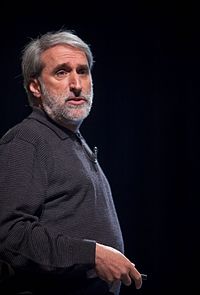Daniel Nocera | |
|---|---|
 Nocera speaking at PopTech | |
| Born | Daniel George Nocera July 3, 1957 Medford, Massachusetts, U.S. |
| Alma mater | Rutgers University (BS) California Institute of Technology (PhD) |
| Known for | Artificial photosynthesis |
| Scientific career | |
| Fields | Chemistry |
| Institutions | Harvard University Michigan State University |
| Thesis | Spectroscopy, electrochemistry, and photochemistry of polynuclear metal-metal bonded complexes (1984) |
| Doctoral advisor | Harry B. Gray |
| Doctoral students | Jenny Y. Yang, Christopher Chang, Michelle C. Chang, Zoe Pikramenou, Kwabena Bediako |
| Other notable students | Jillian Lee Dempsey |
| Website | nocera |
Daniel George Nocera (born July 3, 1957) is an American chemist, currently the Patterson Rockwood Professor of Energy in the Department of Chemistry and Chemical Biology at Harvard University.[1] He is a member of the National Academy of Sciences and the American Academy of Arts and Sciences. In 2006 he was described as a "major force in the field of inorganic photochemistry and photophysics".[2] Time magazine included him in its 2009 list of the 100 most influential people.[3][4]
Nocera has opened up new areas of basic research into the mechanisms of energy conversion in biology and chemistry, including the study of multielectron excited states and proton coupled electron transfer (PCET). He works on research applications in artificial photosynthesis and solar fuels, including an "artificial leaf" that mimics photosynthesis in plants.[5] In 2009, Nocera formed Sun Catalytix, a startup for development of the artificial leaf. The company was bought by Lockheed Martin in 2014.
- ^ Cite error: The named reference
Colenwas invoked but never defined (see the help page). - ^ Cite error: The named reference
APS2006was invoked but never defined (see the help page). - ^ Krupp, Fred (April 30, 2009). "The 2009 Time 100: Daniel Nocera". Time. Retrieved April 6, 2016.
- ^ "The Future of Renewable Energy". BBC World Service. 2013.
How do we develop a practical, reliable, cheap and globally relevant supply of renewable energy and improve on the meagre 10% of our power needs which renewables currently provide? Quentin Cooper travels to the Royal Society of Chemistry's Challenges in Chemical Renewable Energy meeting in Cambridge, UK, to hear about ideas and latest research results from Brazilian authority on bioenergy Carlos Henrique de Brito Cruz, Cambridge University's creator of better batteries Clare Grey, Harvard pioneer of artificial photosynthesis Daniel Nocera and research director of the UK Energy Research Centre Jim Watson.
- ^ Cite error: The named reference
Hallwas invoked but never defined (see the help page).